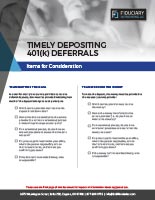
The Story
Dr. Janet has a 401(k) plan. She has 3 employees, none of whom have access to payroll. Every other week on payday, Dr. Janet transfers the employees’ 401(k) contributions to the plan’s recordkeeper.
In June, Dr. Janet decides to take 3 weeks off and take a cruise in Europe. She is going to keep the office open to take calls and handle emergencies, but her backup will handle any patient crises that may arise. Since the office will be open, there will be at least one payroll that occurs while she is overseas.
Dr. Janet doesn’t want to give payroll access to any of the employees. But, the 401(k) deferrals need to be submitted. She decides that she’ll simply hold off and transmit the deferrals when she gets back. She ends up transmitting the 401(k) deferrals after 9 business days, 2 days too late for the safe harbor.
How did they fix it?
Her service provider team determines that she owes interest for 2 days on the amount of the late deferrals, a staggering $0.07. She also owes an excise tax of 15% of the interest or $0.01.
How did they avoid it in the future?
Dr. Janet likes to travel. She realized that it was likely she’d miss timely depositing 401(k) deferrals in the future due to her travels. Despite the small amount of penalty involved. Dr. Janet was concerned that late deposits reported year after year on the plan’s 5500 filing might increase her changes of IRS or DOL audits in the future. After giving the issue some thought. Dr. Janet decided to outsource the transmission of her 401(k) deposits to Fiduciary Outsourcing.

The Mistake
The Department of Labor issued regulations stating that 401(k) deferrals should be transferred to the plan as soon as administratively feasible after payday. Small plans have a safe harbor if they transfer the 401(k) deferrals within 7 business days of payday. Larger plans, those with more than 100 participants, don’t have that safe harbor.
When plans fail to transfer deferrals to the plan as soon as administratively feasible, a prohibited transaction has occurred and the participants must be made whole.
In most audits, the Department of Labor will request a list of all payroll dates in the audit period, the amount of money withheld for 401(k) deferrals for each pay date, and the date the money shows up in the plan. They’ll look at the number of days that elapsed between the paydate and the deposit date. They’ll likely take the smallest number of days and declare that as soon as administratively feasible. Any deposit that took more than that number of days runs a risk of being declared late.

What Happens
The amount that is late must be deposited as soon as possible, with earnings. An excise tax of 15% of the earnings is due to the IRS.
On the Department of Labor website is a late deposit interest calculator. To determine the amount of interest due, you enter the earliest date you could have deposited the money, the actual deposit date and the amount. The calculator then tells you the amount of interest due for that pay period. You must run the calculator for each pay period that money was deposited late.
The amount of interest due is paid to the participants. Normally, we recommend that the entire amount of the interest due be deposited to the plan. However, what do you do if Joe, who terminated in January and was paid his entire account balance as a termination distribution, is due money when the late deposit interest is calculated in June? Do you have to reopen Joe’s account?
There is no definitive answer on what to do with Joe. Imagine that you were one day late on Joe’s only deposit in January. Further imagine that the amount due to him as interest is $0.03. Would you actually reopen Joe’s account and send him a check for $0.03? What if there is a distribution processing fee of $25 to get Joe’s $0.03 check sent to him and participants pay their distribution processing fees?
The key to dealing with Joe is to have an administrative policy that deals with participants who no longer have account balances. Depending on the amount involved, you may decide to divide Joe’s $0.03 between other active participants or to pay the fees to give Joe his $0.03.
Avoid it
The simple answer is to create a process to ensure 401(k) deposits are made the same number of days after pay date every single time. That can be so much easier to say than to do.
Many payroll companies will now transmit the files directly to your plan’s recordkeeper. Some of them will even transmit the money on your behalf the same way they pay employment taxes and state and federal income taxes for you. You should contact your payroll provider and recordkeeper to determine if they offer this service.
If you must create a process on your own, make sure that you create reminders for yourself perhaps in Outlook or a similar type calendaring system. Make sure someone other than you knows how to transfer the 401(k) monies and has the appropriate accesses to do so. Perhaps create a backup reminder for that person’s calendar just in case you are out sick on a transfer date.

How We Help
You have the ability to outsource your responsibilities as the Plan Administrator. As such, you can outsource the responsibility to transmit 401(s) deferrals to Fiduciary Outsourcing. We then assume a fiduciary responsibility with regard to transmitting the plan’s 401(k) deferrals. We would be responsible for any lost interest or excise taxes that might arise if we transmit late.

Checklist

The Story
Dr. Janet has a 401(k) plan. She has 3 employees, none of whom have access to payroll. Every other week on payday, Dr. Janet transfers the employees’ 401(k) contributions to the plan’s recordkeeper.
In June, Dr. Janet decides to take 3 weeks off and take a cruise in Europe. She is going to keep the office open to take calls and handle emergencies, but her backup will handle any patient crises that may arise. Since the office will be open, there will be at least one payroll that occurs while she is overseas.
Dr. Janet doesn’t want to give payroll access to any of the employees. But, the 401(k) deferrals need to be submitted. She decides that she’ll simply hold off and transmit the deferrals when she gets back. She ends up transmitting the 401(k) deferrals after 9 business days, 2 days too late for the safe harbor.
How did they fix it?
Her service provider team determines that she owes interest for 2 days on the amount of the late deferrals, a staggering $0.07. She also owes an excise tax of 15% of the interest or $0.01.
How did they avoid it in the future?
Dr. Janet likes to travel. She realized that it was likely she’d miss timely depositing 401(k) deferrals in the future due to her travels. Despite the small amount of penalty involved. Dr. Janet was concerned that late deposits reported year after year on the plan’s 5500 filing might increase her changes of IRS or DOL audits in the future. After giving the issue some thought. Dr. Janet decided to outsource the transmission of her 401(k) deposits to Fiduciary Outsourcing.

The Mistake
The Department of Labor issued regulations stating that 401(k) deferrals should be transferred to the plan as soon as administratively feasible after payday. Small plans have a safe harbor if they transfer the 401(k) deferrals within 7 business days of payday. Larger plans, those with more than 100 participants, don’t have that safe harbor.
When plans fail to transfer deferrals to the plan as soon as administratively feasible, a prohibited transaction has occurred and the participants must be made whole.
In most audits, the Department of Labor will request a list of all payroll dates in the audit period, the amount of money withheld for 401(k) deferrals for each pay date, and the date the money shows up in the plan. They’ll look at the number of days that elapsed between the paydate and the deposit date. They’ll likely take the smallest number of days and declare that as soon as administratively feasible. Any deposit that took more than that number of days runs a risk of being declared late.

What Happens
The amount that is late must be deposited as soon as possible, with earnings. An excise tax of 15% of the earnings is due to the IRS.
On the Department of Labor website is a late deposit interest calculator. To determine the amount of interest due, you enter the earliest date you could have deposited the money, the actual deposit date and the amount. The calculator then tells you the amount of interest due for that pay period. You must run the calculator for each pay period that money was deposited late.
The amount of interest due is paid to the participants. Normally, we recommend that the entire amount of the interest due be deposited to the plan. However, what do you do if Joe, who terminated in January and was paid his entire account balance as a termination distribution, is due money when the late deposit interest is calculated in June? Do you have to reopen Joe’s account?
There is no definitive answer on what to do with Joe. Imagine that you were one day late on Joe’s only deposit in January. Further imagine that the amount due to him as interest is $0.03. Would you actually reopen Joe’s account and send him a check for $0.03? What if there is a distribution processing fee of $25 to get Joe’s $0.03 check sent to him and participants pay their distribution processing fees?
The key to dealing with Joe is to have an administrative policy that deals with participants who no longer have account balances. Depending on the amount involved, you may decide to divide Joe’s $0.03 between other active participants or to pay the fees to give Joe his $0.03.
Avoid it
The simple answer is to create a process to ensure 401(k) deposits are made the same number of days after pay date every single time. That can be so much easier to say than to do.
Many payroll companies will now transmit the files directly to your plan’s recordkeeper. Some of them will even transmit the money on your behalf the same way they pay employment taxes and state and federal income taxes for you. You should contact your payroll provider and recordkeeper to determine if they offer this service.
If you must create a process on your own, make sure that you create reminders for yourself perhaps in Outlook or a similar type calendaring system. Make sure someone other than you knows how to transfer the 401(k) monies and has the appropriate accesses to do so. Perhaps create a backup reminder for that person’s calendar just in case you are out sick on a transfer date.

You have the ability to outsource your responsibilities as the Plan Administrator. As such, you can outsource the responsibility to transmit 401(s) deferrals to Fiduciary Outsourcing. We then assume a fiduciary responsibility with regard to transmitting the plan’s 401(k) deferrals. We would be responsible for any lost interest or excise taxes that might arise if we transmit late.

Checklist

